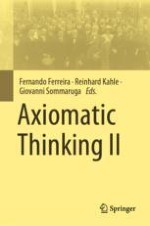2022 | Book

Axiomatic Thinking II
Editors: Fernando Ferreira, Reinhard Kahle, Giovanni Sommaruga
Publisher: Springer International Publishing
2022 | Book

Editors: Fernando Ferreira, Reinhard Kahle, Giovanni Sommaruga
Publisher: Springer International Publishing
In this two-volume compilation of articles, leading researchers reevaluate the success of Hilbert's axiomatic method, which not only laid the foundations for our understanding of modern mathematics, but also found applications in physics, computer science and elsewhere.
The title takes its name from David Hilbert's seminal talk Axiomatisches Denken, given at a meeting of the Swiss Mathematical Society in Zurich in 1917. This marked the beginning of Hilbert's return to his foundational studies, which ultimately resulted in the establishment of proof theory as a new branch in the emerging field of mathematical logic. Hilbert also used the opportunity to bring Paul Bernays back to Göttingen as his main collaborator in foundational studies in the years to come.
The contributions are addressed to mathematical and philosophical logicians, but also to philosophers of science as well as physicists and computer scientists with an interest in foundations.